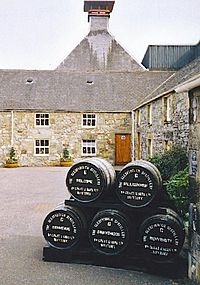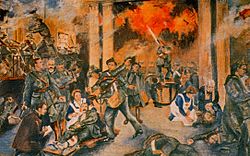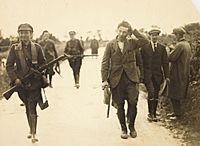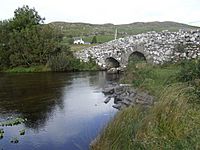Maurice Walsh facts for kids
Quick facts for kids
Maurice Walsh
|
|
|---|---|
| Born | 2 May 1879 Ballydonoghue, near Listowel, County Kerry, Ireland |
| Died | 18 February 1964 (aged 84) Blackrock, Dublin, Ireland |
| Occupation | Writer |
| Nationality | Irish |
| Genre | historical fiction, myth and legend |
| Notable works |
|
Maurice Walsh (born May 2, 1879 – died February 18, 1964) was an Irish writer. He is best known for his short story "The Quiet Man." This story was later made into a famous movie of the same name. The film won an Oscar and starred John Wayne and Maureen O'Hara. In the 1930s, Maurice Walsh was one of Ireland's most popular authors.
A new musical based on his book, Castle Gillian, is currently being created.
Life of Maurice Walsh
Maurice Walsh was born around April 21, 1879. His birthplace was Ballydonoghue, a small area near Listowel in County Kerry, Ireland. He was the third of ten children. His father, John Walsh, was a local farmer. His mother was Elizabeth Buckley. The family lived in a small, three-room farmhouse with a thatched roof.
His father was involved in the Irish National Land League, a group that helped farmers. But his main interests were books and horses. He hired others to work on the farm. One farmhand, Paddy Bawn Enright, later inspired a character in "The Quiet Man." Maurice's father taught him to love books, Irish legends, and folk tales. These stories and ideas about places often appeared in Maurice's own writing.
Walsh wrote about 20 novels and many short stories. Many of his tales were set in Scotland or the West of Ireland. They often mixed drama with romance. His stories showed a rural Ireland that was changing quickly in the 1930s. While not widely read today, his books were very popular back then. They were translated into many languages, including Italian, German, and French.
In 1908, he married Caroline Begg, who was called "Toshon." She was from Scotland. They had three sons, Ian, Neil, and Maurice. They also had two daughters, Molly and Elizabeth, who sadly died young. One of his grandsons is the Irish painter Manus Walsh. Caroline passed away in 1941. Maurice Walsh died on February 18, 1964, in Blackrock, Dublin. He was buried in the Esker cemetery in Lucan, County Dublin. The President of Ireland, Éamon de Valera, even attended his funeral.
Maurice Walsh's Career
Maurice Walsh went to school in Lisselton. He later attended St Michael's College in Listowel. He studied there to prepare for the Civil Service exam. In 1901, he joined the Customs and Excise Service. This job involved collecting taxes on goods. His first job was in Limerick, Ireland. Then he was sent to Scotland.

He spent most of his time in Scotland working in the Scottish Highlands. His job there was to check on whisky factories. This is where he met Neil Gunn, another writer who also worked in the Excise Service. They became close friends.
In 1908, Walsh sold two stories to The Irish Emerald. This was a magazine in Dublin that featured Irish writers. One of these stories, "Eudmon Blake," later became the basis for his 1932 novel Blackcock's Feather.
In 1922, Walsh moved to the Excise service of the new Irish Free State. This was a new independent part of Ireland. He moved to Dublin. The founding of the Free State led to the Irish Civil War (1922-1923). This was a conflict between different groups in Ireland. Because of the war, Walsh left his family in Scotland. They joined him in 1923 when it was safe.
During this time apart, Walsh wrote his first novel, The Key Above the Door. He entered it in a competition. Even though it didn't win, it was published in 1926. It sold over 250,000 copies! Over the next ten years, he published many short stories. These appeared in magazines like The Dublin Magazine. His book sales grew a lot after J. M. Barrie, the author of Peter Pan, praised The Key Above the Door.
In 1932, Walsh published Blackcock's Feather. This book was even translated into Irish for use in schools. He stopped working for the government the next year to become a full-time writer. Soon after, he sold his short story "The Quiet Man" to The Saturday Evening Post. This was a popular US magazine.
"The Quiet Man" was included in his 1935 collection called Green Rushes. Some stories in this collection were darker than his other work. They featured Hugh Forbes, a member of the IRA during the Irish War of Independence. The director John Ford even gave Forbes a small part in the 1952 film The Quiet Man.
Walsh became the President of the Irish branch of International PEN in 1938. This is a group for writers. He visited the United States that year. When World War II started in 1939, he wrote an article defending Ireland's neutrality. After the war, he published more short story collections. The most popular ones featured a character named Tomasheen James.
Many of his works were made into films or plays. The 1952 Oscar-winning film The Quiet Man is the most famous. Another film in 1954 was loosely based on his book Trouble in the Glen. However, this film was not very popular. Some of his other books were also read on the radio.
Maurice Walsh's Legacy
Today, Maurice Walsh is mostly remembered for his short story "The Quiet Man." But in the 1930s and 1940s, he was one of Ireland's top-selling authors. Some say even Ernest Hemingway admired his work. His historical novels were set in interesting times. For example, Blackcock's Feather (1932) is about the Nine Years War (1594-1603). His 1937 novel And No Quarter follows the campaigns of Montrose in the 1640s. Sons of the Swordmaker goes back to the first century BCE.

Much of his writing came after the 1923-1924 Irish Civil War. This war was especially harsh in his home county of Kerry. One very sad event happened at Ballyseedy. Prisoners were tied to a bomb, and it exploded.
Like other Irish writers of his time, such as W. B. Yeats, Walsh was influenced by Romantic nationalism. This idea suggested that being Irish was about a shared culture and landscape. It wasn't just about race, politics, or religion. This idea was very appealing in Ireland, which was divided in the 1920s and 1930s.

The poet Seamus Heaney described Walsh's writing style as having "an atmosphere, a sense of bogs and woods." In his novels, Walsh often wrote about a united Ireland. He believed people could be united no matter their background or religion. For example, in And No Quarter, the hero is an Englishman who is Protestant. The five stories in Green Rushes, including "The Quiet Man," show IRA members dealing with their memories of the fighting.
However, after 1922, the idea of Romantic Nationalism became less important. Walsh's writing style became less popular in the 1950s.
He is listed in important books about authors, like Catholic Authors and the Macmillan Dictionary of Irish Literature.
Books by Maurice Walsh
- The Key Above the Door (1926)
- While Rivers Run (1928)
- The Small Dark Man (1929)
- Blackcock's Feather (1932)
- The Road to Nowhere (1934); a story about poaching and romance in the Scottish Highlands.
- Green Rushes, which includes The Quiet Man and other related stories (1935)
- And No Quarter (1937)
- Sons of the Swordmaker (1938)
- The Hill Is Mine (1940)
- Son of Apple (1940), an old Irish folk story retold.
- Thomasheen James, Man-of-no-Work (1941)
- The Spanish Lady (1943)
- The Man in Brown (1945)
- Castle Gillian (1948); follows two couples who run an Irish horse racing stable.
- Trouble in the Glen (movie adaptation) (1950)
- Son of a Tinker, a collection of short stories (1951)
- The Honest Fisherman, another collection of short stories (1953)
- A Strange Woman's Daughter (1954)
- Danger Under the Moon (1956)
- The Smart Fellow, a collection of short stories (1964)



